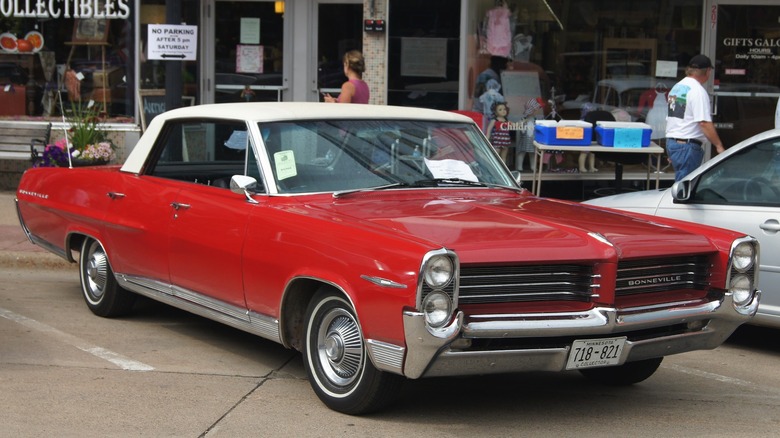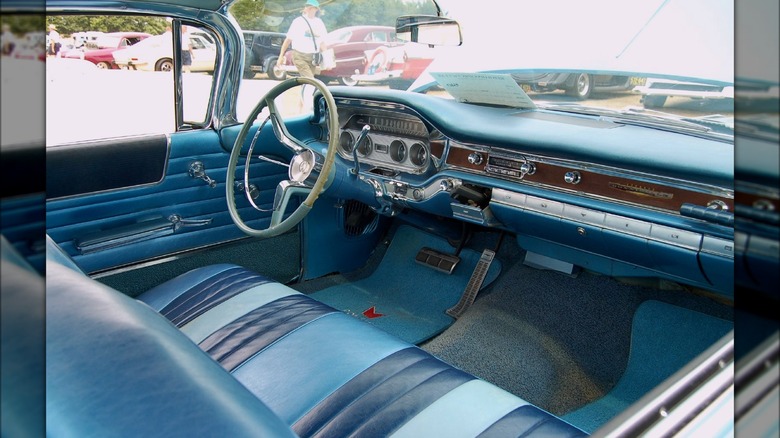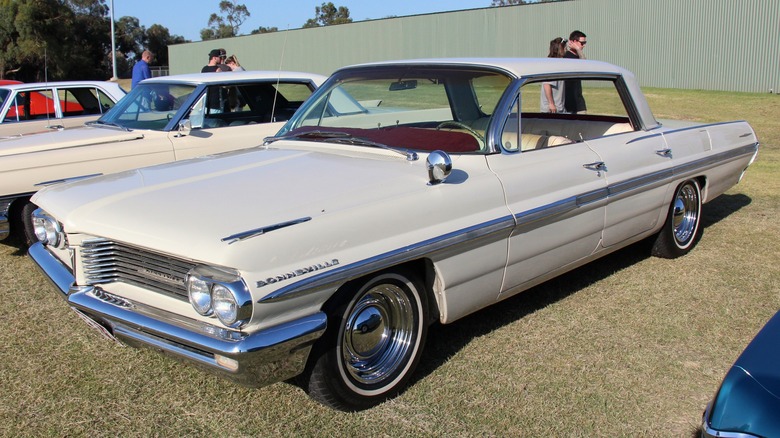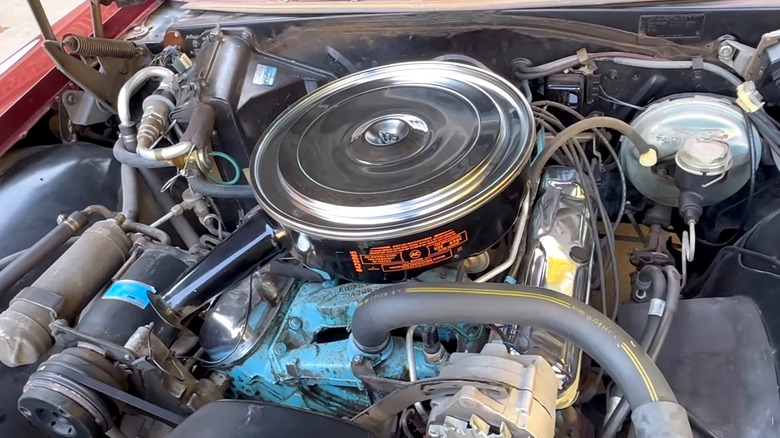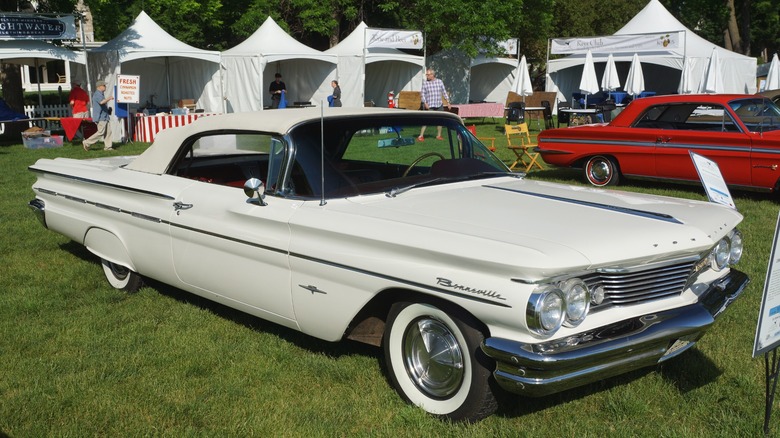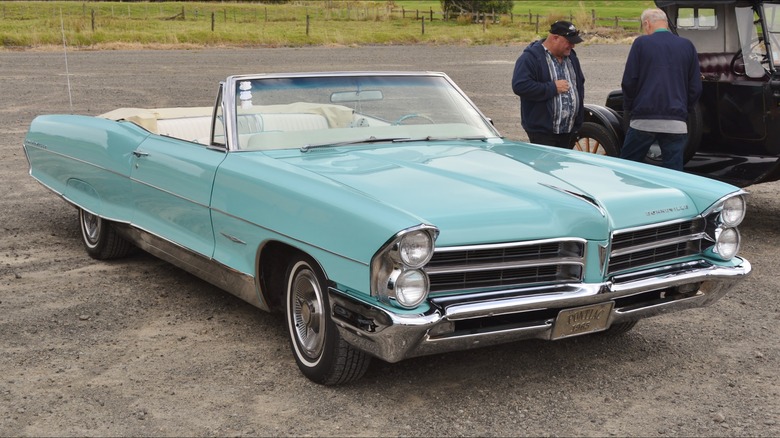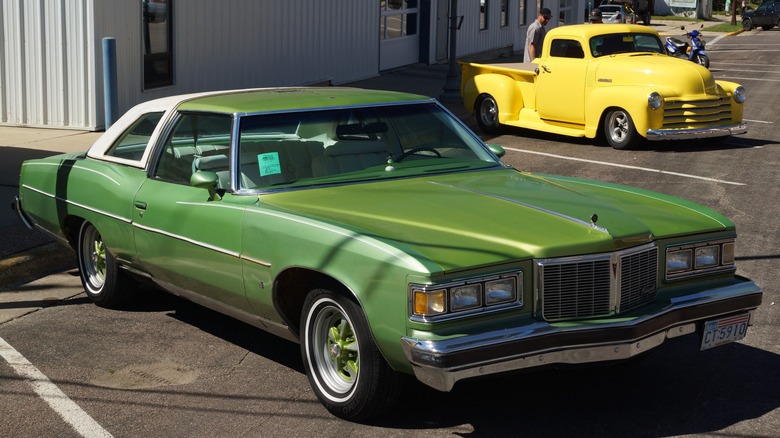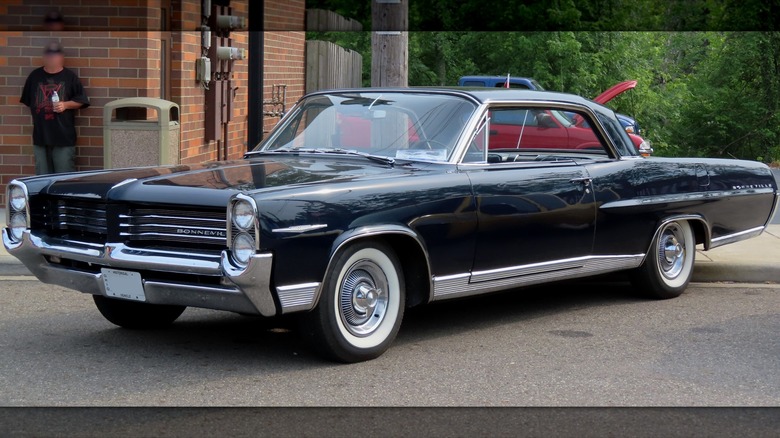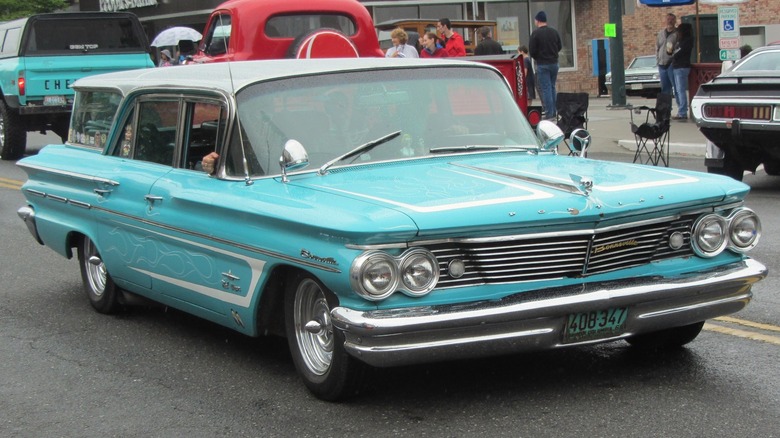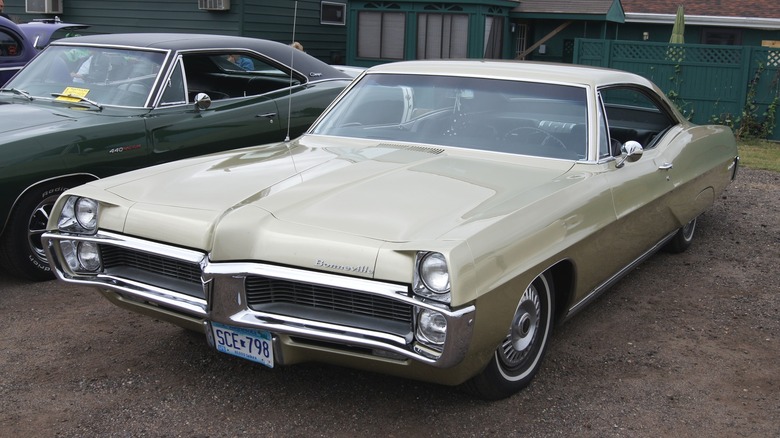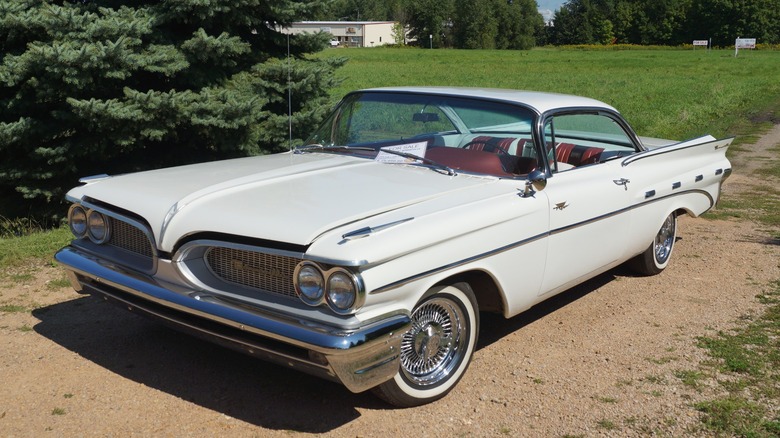10 Reasons A Classic Pontiac Bonneville Is Still Worth Buying Today
When you think of old-school Pontiac luxury, the Bonneville name is likely the one that comes to mind. Launching as an exclusive convertible version of the Star Chief in 1957, Pontiac would promote the Bonneville to model status in 1958, kickstarting six generations of luxury cruisers that would run until 1981. The nameplate survived after that, of course, but in mid-sized and, later, front-wheel-drive guises, neither of which ever reached the same heights as their 1960s and 1970s predecessors.
Through the 1960s and 1970s, the Bonneville sat at the top of Pontiac's full-size luxury fleet, bigger and more luxurious than the Catalina below it. Available in a range of body styles and with torquey V8 engines for all of its early years, the Bonneville was a hit with journalists and consumers alike; Pontiac managed to move more than 100,000 units of the relatively expensive Bonneville during its mid- to late-1960s heyday, which is no mean feat.
Of course, the Bonneville isn't the only choice if you're after old-school American luxury, with iconic Fords like the Thunderbird and full-sized Chrysler models also worth considering. Those may seem more appealing (who wouldn't want a Thunderbird?), but we think there are plenty of reasons to consider a Pontiac Bonneville alongside, or even in place of, its Detroit rivals; here are 10 that might just sway you.
[Image by Greg Gjerdingen via Wikimedia Commons | Cropped and scaled | CC BY 2.0]
Classic full-sized luxury
The Bonneville was the crowning jewel of Pontiac's full-size, luxury-minded fleet in its heyday. While what it offers may not quite match what we can expect from the best luxury car brands in this day and age, the Bonneville is still a great choice if you want a classic V8-powered car that offers more than the bare minimum on the inside.
Pontiac pulled out all the stops for the Bonneville's interior for the 1958 model, with that year's classic exterior lines matched by Lustrex or hand-buffed leather upholstery, depending on the body style. The company started offering Morrokide fabrics the next year while retaining the leather upholstery on the convertible. Polished walnut and stainless steel added a touch of class to the dashboard, while instrument panel cushioning and full nylon pile carpeting added an extra layer of luxury. Pontiac began offering Province and Ponchartrain cloth to the interior later that decade, letting buyers customize their experience even further.
Combine all this with the smooth ride, and sitting behind the wheel in a Bonneville will likely be one of the more comfortable experiences you'll have in a classic American car. The big task, of course, is to find a Bonneville with a great interior — or to put in the work to get a poor one back up to factory condition (or better).
[Image by Joe Ross via Wikimedia Commons | Cropped and scaled | CC BY-SA 2.0]
Grand-tourer comfort
If you're interested in sharp handling and carving corners, you're probably not considering a full-sized, V8-powered American car from the 1960s, especially not a Bonneville. But that doesn't mean it's unpleasant to drive. Instead, what the Bonneville lacks in sheer handling prowess, it makes up for somewhat in comfort.
The mid-60s Bonneville, for example, is known as a smooth cruiser, with contemporary reviews praising the ride quality of the 1965 Bonneville even compared to other full-size luxury Pontiacs. Despite being more of a highway cruiser, the mid-60s Bonneville had reasonably controlled body roll and wasn't totally incapable in the turns, either. The Bonneville retained its reputation into the 1970s, with Road & Track praising the 1977 model's smooth ride and above-average handling — even if it had to admit that Detroit's offering paled when compared to the new German upstarts coming into the luxury market back then.
None of this is likely to impress now, but it's at least a decent starting point. Modernizing the suspension is an option, too. You can install coilover kits to add a bit of sportiness, but air suspension might just be the ticket instead: you're buying a cruiser here, after all, so why not lean into it?
[Image by Cars Down Under via Flickr | Cropped and scaled | CC BY 2.0]
Tire-smoking V8 power
Yes, the Pontiac Bonneville had all the luxury trappings that the 1960s and 1970s could offer, but it was still an American car in the days when V8s ruled the roost. This means that, for all of the nameplate's famed elegance and classiness, most Bonnevilles from the 1960s and early 1970s had enough torque to smoke tires at will.
Bonnevilles had big power from the word go, with buyers of the 1958 Bonneville capable of speccing a fuel-injected, 310-hp, 400 lb-ft version of the Tempest 395 V8. Even the base version of the engine had impressive pulling power, making 388 lb-ft even with a lowly two-barrel carburetor. The Tempest 395 became the Tempest 425 in 1960 before the Trophy V8 took its place the next year.
Pontiac continued updating its V8 offerings through the rest of the decade: buyers could choose from several 389- and 421-CI V8s for 1965, for example, and Pontiac would later introduce the legendarily reliable Pontiac 428 at the end of the decade. The 428 made 360 hp and 445 lb-ft in its standard form, or 390 hp and 465 lb-ft in high output configuration. Pontiac wasn't done, though: the first few years of the fifth-gen Bonneville saw its standard 455-CI V8 produce 360 hp and an impressive 500 lb-ft of torque before emissions regulations put the kibosh on the fun. Pontiac stuck with V8s for the rest of the fifth and sixth generations, but these post-Clean Air Act engines never hit the same heights as their forebears.
Not a bad looking generation in the bunch
Performance and luxury are all well and good, but a car's looks can be just as — if not more — important. After all, what good is great straight-line speed and a cushy interior if the car's so ugly that you wouldn't want to be caught dead in one? If you're investing the money and time into a classic, why not get something that makes you feel good when you see it parked in your driveway? Thankfully, the classic Bonnevilles offer that — across nearly two decades.
Well, to be clear, the first and sixth generations are outliers, in a sense: the first had that pure 1950s space-age look, while the sixth is when the Bonneville started transitioning into a less appealing 1980s box. We definitely like the first-generation Bonneville, but the sixth-gen isn't quite our thing, although you could do a lot worse. But we think the second to fifth generations are the best, with their full-sized sheet metal, sleek lines, and classy elegance.
You can't really go wrong if you're buying an old-school Bonneville. Sure, the changes between generations were sometimes quite drastic — stacked headlights on the early fourth-generation model, anyone? — and everyone will have their favorite look, but that's a good thing. More great body styles means more options, so you're not locked into fighting over that particular one particular body style everyone wants. Well, hopefully, at least.
[Image by Greg Gjerdingen via Wikimedia Commons | Cropped and scaled | CC BY 2.0]
Drop-top fun
Befitting its position at the top of Pontiac's range, the Bonneville came in a few body styles during its classic run. You could get two- and four-door bodies, but Pontiac also offered the Bonneville as a convertible. Old-school American V8 luxury and the wind in your hair; what's not to like there?
The Bonneville started life as a convertible-only trim level for the Star Chief, so it makes a lot of sense that Pontiac would continue that heritage after it promoted the Bonneville to a standalone model. Pontiac continued offering two-door convertible bodies for the next decade, with the first- to fourth-generation Bonneville all available in this body style. Early convertible Bonnevilles were a cut above their hardtop versions, too: 1958 to 1960 Bonneville Convertibles — the first and second generation — came with full-on leather interiors as standard, perfect for showing off while cruising downtown.
Of course, knowing that convertible Bonnevilles are out there means little if they're impossible to track down. Thankfully, that's not the case — at least, not entirely. They're not as common as the hardtops, but Pontiac built quite a few convertibles in the 1960s: around 21,000 left the factory in 1962 and 1965, for example, so they don't always command a huge premium over hardtop versions.
[Image by GPS 56 via Wikimedia Commons | Cropped and scaled | CC BY 2.0]
Later generations are still affordable
If you feel like you've been priced out of owning some classic V8-powered American luxury, then the Bonneville is a car you'll want to check out. Well, the first two generations aside, at least: good-condition 1958 Bonnevilles can command six-figure sums, while second-generation examples tend to go for around $50,000 on average (based on Classic.com's price tracking). Not quite on par with the rarest Pontiacs ever made price-wise, but still a good chunk of change.
Thankfully, the following generations aren't quite as heavy on the wallet. Third-gen Bonnevilles can still be quite pricey, but you can also find ones for around the $25,000 mark, which isn't all that bad. Fourth-generation examples can be even cheaper, with many going for less than $20,000 over the past year. Sure, they're maybe not as iconic as the first two generations, but they're still great-looking cars with classic Pontiac V8s under the hood.
Prices for fifth- and sixth-generation Bonnevilles can go even lower, although that comes with the downside of these being probably the least-desirable generations for the classic Bonneville. We've seen sellers ask between $10,000 and $15,000 for '70s Bonnevilles on eBay, which isn't too bad, really.
[Image by Greg Gjerdingen via Wikimedia Commons | Cropped and scaled | CC BY 2.0]
Could be a decent investment
Before we start, a word of warning: we don't know where used car prices will go, and the desirability — thus, price — of a classic car rides on a ton of factors that make predicting future value impossible. So take this more as a fun point to consider if you're already in the market for a classic Bonneville rather than advice about how you should spend your money.
Average selling prices for first and second-generation Bonnevilles have dipped below their historical highs and may continue to drop; this won't make them cheap, but it could be a chance to get a good investment piece at a better price than just 12 months ago. But what's more interesting is the later generations, especially the third and fourth ones.
Average selling prices, per Classic.com, have been reasonably stable over the past few years, which is a decent sign. There's also the fact that these never hit the crazy highs of their earlier counterparts, so the prices may not dip as far as the first two generations (if they do at all). There's a decent chance you'll get your money back down the line, provided you keep your Bonneville in good condition. You may even want to take a chance on the fifth and sixth-gen Bonnevilles in the hope that nostalgia propels them to a 1982 Toyota Land Cruiser-style price rally in a few years. Crazier things have happened.
[Image by MercurySable99 via Wikimedia Commons | Cropped and scaled | CC BY-SA 4.0]
There's a wagon, too
Maybe convertibles aren't your thing, but you want something other than a standard coupe or sedan body style. Well, you're in luck: Pontiac built Bonneville wagons, too. The company started offering a wagon body style in 1959, with the second-generation Bonneville — and Catalina — available in Safari guise, the term Pontiac used for its station wagons. These, of course, had an extended roof and slightly altered tailgate, although they retained the taillight fins. Later Bonneville wagons followed the hardtop design styles, with simpler, but cleaner lines.
Pontiac dropped the wagon body style for 1971 but would bring it back later that decade, basing the 1978 Grand Safari on the sixth-generation Bonneville. And it's glorious, with its square body and wood veneer giving it perfect 1970s cool. Maybe not quite enough to be one of the coolest station wagons ever, but we think it has a chance of sneaking into a top 10 list.
Now, the bad news: Pontiac didn't build many Bonneville Safaris, at least not in the early 1960s. Agreed-upon production numbers show that Pontiac didn't build all that many Bonneville wagons, with fewer than 8,000 units yearly up until the end of the fourth generation. Pontiac built quite a bit more Bonneville-based Grand Safaris — well, in 1978, at least — and they seem to go for very affordable prices when they pop up.
[Image by John Lloyd via Flickr | Cropped and scaled | CC BY 2.0]
Solid parts availability
Old cars come with old car problems; unless you buy a pristine example, you'll likely have to perform some maintenance to keep your classic Pontiac Bonneville running smoothly. Thankfully, that doesn't look like it'll be too hard — at least as far as the mechanical parts go.
You can get a bunch of used and OEM parts for Pontiac Bonnevilles from eBay sellers, with the popular auction site allowing you to filter parts by year, make, and model. Whether it's a major upgrade, such as a disc brake conversion kit, or a quick replacement, such as new headlights, you should be able to source what you need from eBay. Of course, eBay isn't your only option; reputable parts stores like Summit Racing also sell OEM and replacement parts for old muscle cars, the Pontiac Bonneville included. If it fades over the years, you can also find interior refurbishing supplies to revive some of that famed luxury.
One area where you will have some issues, however, is with the sheet metal. Sherman Parts sells floor pans for most classic Bonneville models, but that's about it. Even Classic Industries, who stock a ton of reproduction sheet metal for muscle cars like the Dodge Challenger, don't have much to offer. Unless you want to trawl the internet — and junkyards — for used quarter panels, try to get a Bonneville with as rust-free a body as possible.
[Image by Greg Gjerdingen via Wikimedia Commons | Cropped and scaled | CC BY 2.0]
A slice of Pontiac history
When you buy a classic car, you're not just buying a set of wheels. You're also getting a hold of, in many cases, automotive history, the material manifestations of some clever idea — like the John DeLorean-inspired second-generation Pontiac Grand Prix, for instance — or landmark moment in popular culture. However, while the Bonneville might not have the same pop cultural cachet as other Pontiac classics, the nameplate still holds a lot of weight for fans of GM's one-time "excitement division."
The Bonneville was one of the models that helped usher in two signature features that would characterize Pontiac cars of the 1960s and 1970s: Wide-Track and the split front grille. Wide-Trak was the creation of Pontiac general manager Semon E. "Bunkie" Knudsen, who felt that the new-for-1959 Bonneville body was too wide for the chassis.
1959 was also the year that Pontiac opted to refresh its cars with the now-signature split front grille, with that year's Star Chief, Catalina, Safari, and Bonneville all having the new-look front. It wasn't Pontiac's first flirtation with a split front grille, with pre-war cars like the 1930s Silver Streak arguably pioneering the look, but it's the one that most will remember. Split grilles would be a mainstay on cars like the Pontiac Firebird through its many redesigns, and it all started with the Bonneville.
[Image by Greg Gjerdingen via Wikimedia Commons | Cropped and scaled | CC BY 2.0]
